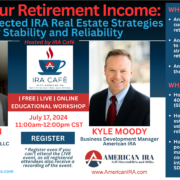What the “Uninitiated” May Not Know About Self-Directed IRAs
You may have heard this phrase before: “for the uninitiated…” And it is something that we throw around a lot in the Self-Directed IRA world. Why? Because many people—including many experienced investors—are not fully aware of what a Self-Directed IRA does, or how it even works. That is why we have decided to put together some of the most important points about Self-Directed IRAs for anyone who feels that they are just being introduced to this topic. Here is what you will need to know:
Defining the Self-Directed IRA in Simple Terms
To define Self-Directed IRAs, we first have to define what an IRA is. According to Investopedia, “An individual retirement account (IRA) is a tax-advantaged account that individuals use to save and invest for retirement.” You might notice that this definition is short on specifics. Why is that? Because an “IRA” can technically refer to a large number of different account types, including:
- Traditional IRAs
- Roth IRAs
- SEP-IRAs, or Simplified Employee Pension IRAs
Each account type has its unique quirks. For example, a Roth IRA is funded using after-tax dollars, which means that an investor will have more flexibility with that money later in retirement, since the funds were already taxed. For example, within a Roth IRA, an investor can continue contributing as long as they like, and never take anything out if they do not want to—after all, it is their money. For a Traditional IRA, investors will have to start taking retirement distributions at a certain age to help ensure that the before-tax (or tax-deductible) money put into the account does eventually get taxed.
What is Self-Direction?
It all makes sense so far. Many of us are aware of what an IRA is, or at least the concept of investing in a tax-advantaged retirement account. But what happens when an investor encounters a phrase like self-direction? As it applies to retirement accounts, it is exactly how it sounds: rather than working solely through a broker who establishes which funds you can choose from, you will be responsible for selecting your own investments in the IRA.
Why bother? Because selecting your own investments can provide a greater degree of freedom. And here is what interests the uninitiated: you may have more retirement options than you know. For example, did you know that you can hold real estate within a Self-Directed IRA? Precious metals? Private stock? Even promissory notes? These assets help investors diversify out of the stock market. And for many investors with specific experience in these asset classes, it can be a great way to build wealth.
Self-direction can be a tricky topic for some because it also means that they are taking on more responsibility. Rather than rely on a broker to handle the ins and outs and the paperwork, you are taking on more yourself. But that is where a Self-Directed IRA administration firm comes in.
Working with a Self-Directed IRA Administration Firm
A Self-Directed IRA administration firm is an entity which can serve as the “custodian” on the account, helping to execute paperwork and transactions to ensure that everything is done the right way. Because there are specific rules regulating how retirement accounts can work, individual investors have to be wary of running afoul of those rules. Working with a Self-Directed IRA administration firm can help. With a trusted firm on your side, you can execute paperwork and transactions easily. It means that even though you are in charge, you can still rely on a trusted firm—not an adviser—to handle issues like administrative work.
Interested in learning more about Self-Directed IRAs? Contact American IRA, LLC at 866-7500-IRA (472) for a free consultation. Download our free guides or visit us online at www.AmericanIRA.com.







